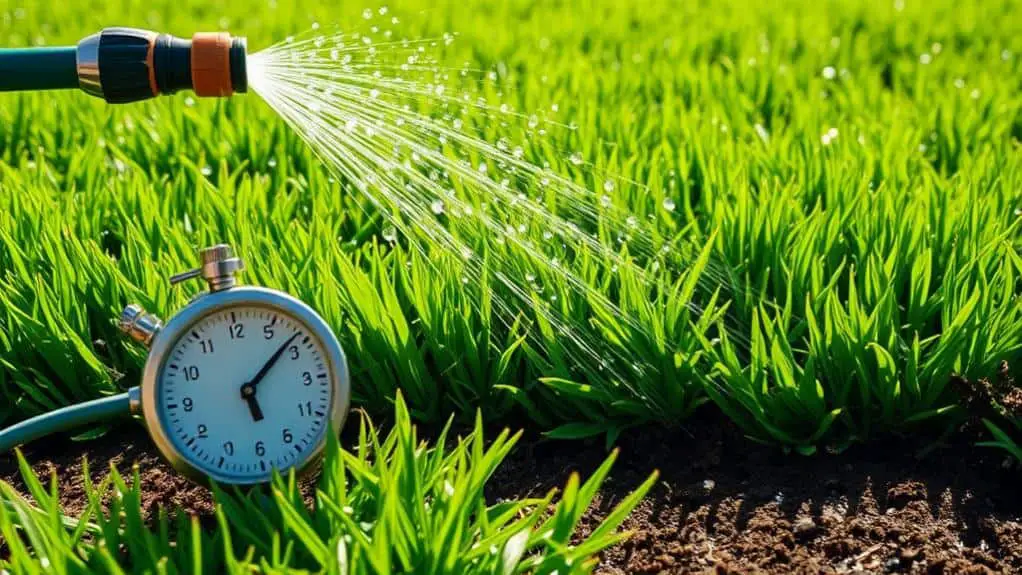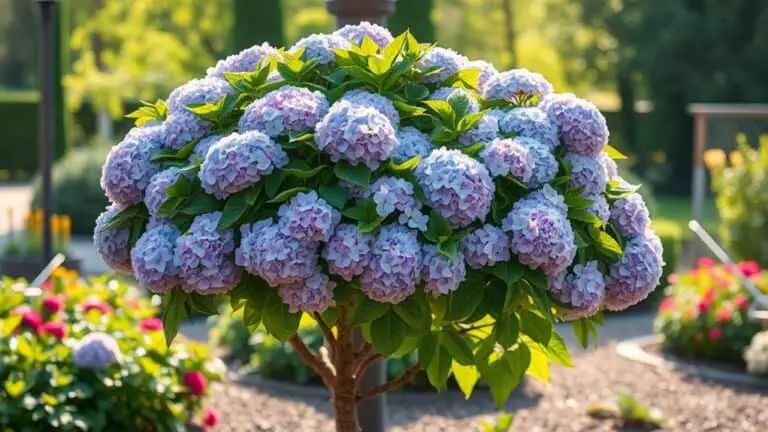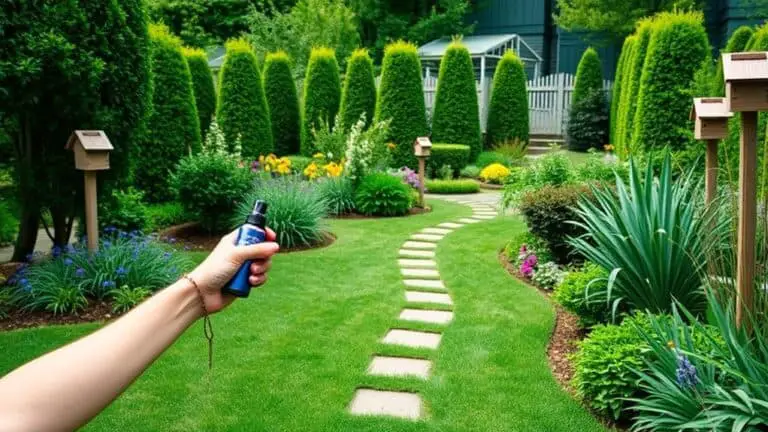How Long Should You Water A Lawn For
When it comes to watering your lawn, the right balance is essential. I've found that aiming for about 30 minutes to an hour per session works best, but there's more to take into account. Factors like the type of grass, seasonal changes, and even the specific watering techniques you use can greatly impact your lawn's health. For instance, using rotor heads for 25-35 minutes per zone guarantees even distribution. But, how do you adjust for summer versus winter, and avoid common pitfalls like overwatering? Let's explore these nuances to make certain your lawn thrives year-round.
Watering Needs and Frequency

When it comes to watering your lawn, understanding its needs and frequency is key to maintaining a healthy, vibrant yard. You should water your lawn every week, aiming for about 1 inch of water per week. This amount keeps the grass hydrated and resilient.
Adjust your watering schedule based on the season; in summer, you might need to water 3-4 times a week, while winter requires less frequent watering. Different soil types and weather conditions are factors that affect how often you should water. Sandy soil needs more frequent watering, while clay soil can hold moisture longer.
Monitoring soil moisture and ensuring deep root growth helps maintain lawn health. Remember, the best time to water is early morning or late evening.
Optimal Watering Timing
Ideal watering timing is essential for a healthy lawn, and the best time to water is early morning, ideally between 6 a.m. and 10 a.m., to reduce evaporation and allow the grass to dry before nightfall.
Avoid watering in the evening because it can leave your lawn too wet, leading to fungal diseases.
Remember to adjust your watering schedule with the seasons—less frequent watering in the cooler spring and more in the hot summer months keeps your lawn thriving.
Early Morning Benefits
Ever wondered why early morning is the best time to water your lawn? Let me tell you!
Watering in the early morning, between 6 a.m. and 10 a.m., is super effective for a few reasons. It guarantees peak absorption, helping you keep a healthy lawn. Plus, it provides the ideal 1 inch of water needed weekly.
Morning watering also minimizes evaporation and allows grass blades to dry before nightfall, reducing the risk of fungal diseases.
Here's why early morning watering rocks:
- Peak absorption: Grass absorbs water better in cooler temperatures.
- Healthy lawn: Proper hydration promotes strong root growth.
- Fungal diseases: Reduces risks by allowing grass to dry.
- Balanced moisture: Maintains soil moisture during the day.
- Automation: Easy to set up with irrigation systems.
Avoid Night Watering
Avoiding night watering is essential for maintaining a healthy lawn. When you water at night, the moisture stays on the grass blades longer, which can lead to fungal growth. This dampness overnight creates an ideal environment for diseases to thrive.
Instead, opt for early morning watering. It allows the grass blades to dry before nightfall, helping to prevent fungal issues and promoting healthier grass. Plus, watering in the morning reduces evaporation losses, ensuring more water reaches the roots.
Consistent early morning watering not only prevents disease but also contributes to stronger, deeper root growth, making your lawn more resilient. By adjusting your watering schedule, you can keep your lawn looking lush and green.
Seasonal Timing Adjustments
Knowing when to water your lawn throughout the year can make a significant difference in its health and appearance. Adjusting your watering schedule according to the seasons guarantees your lawn gets the right amount of water per week.
In spring, water once or twice a week for about 15 minutes. During summer, increase it to 30 minutes, three times a week to combat heat stress.
Come fall, reduce to once or twice a week, watering later in the morning for around 20 minutes. In winter, water once a week for 15 minutes, but avoid watering during dormancy in colder climates.
- Early morning is the best time of day
- Spring: 15 minutes, once or twice a week
- Summer: 30 minutes, three times a week
- Fall: 20 minutes, once or twice a week
- Winter: 15 minutes, once a week
Watering Duration and Techniques

When it comes to watering your lawn, understanding the right duration and techniques can make all the difference in maintaining a lush, green yard. A key aspect is the watering duration. Deep watering promotes root growth and water retention, enhancing your lawn's resilience.
One hour typically delivers the needed 1 inch of water weekly. For rotor heads, aim for 25-35 minutes per zone, while spray heads need 10-15 minutes. Avoid frequent short sessions; they're ineffective.
Try measuring water with a tuna can to guarantee even sprinkler output. Regularly check and adjust to prevent water runoff. Proper techniques guarantee your lawn stays healthy and green, making your efforts worthwhile.
Ideal Watering Schedule
To maintain a healthy lawn, it's essential to establish an ideal watering schedule tailored to your region's climate and your grass type. In North Texas, aim for about 1 inch of water per week.
During the growing season, try two 30-minute sessions weekly to promote deep roots and resilience. In the summer heat, increase the watering frequency to three times a week. It's best to water early in the morning to minimize evaporation and reduce fungal risks.
If you use a sprinkler system, follow these guidelines:
- Rotary heads: 25-35 minutes per zone
- Spray heads: 10-15 minutes per zone
- Adjust duration based on grass type
- Monitor weather conditions
- Check soil moisture regularly
This keeps your lawn lush and vibrant!
Types of Grass
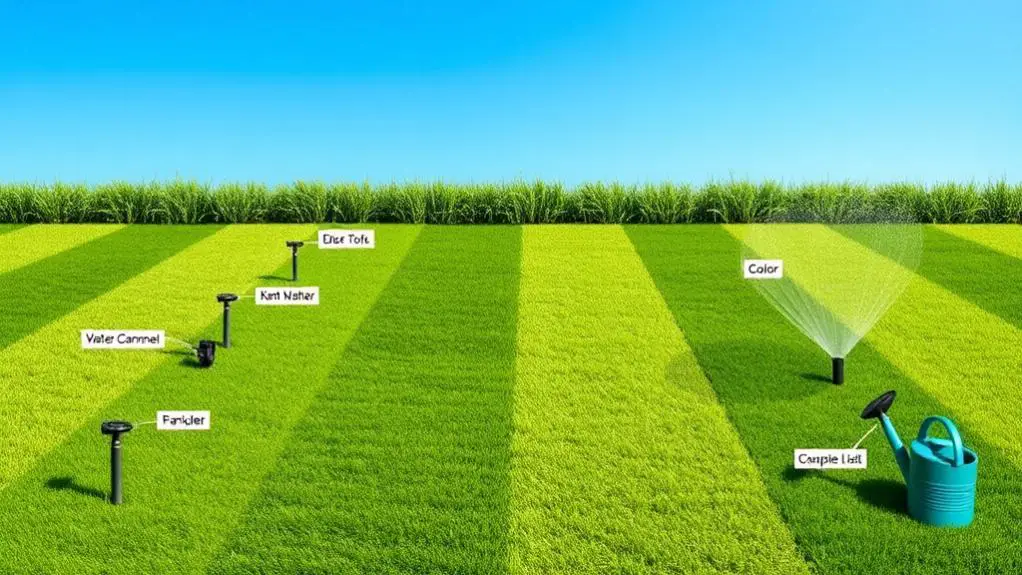
When it comes to watering your lawn, the type of grass you have makes a big difference.
For cool-season grasses like Kentucky bluegrass, you'll need to water more frequently, especially in the summer, while warm-season grasses like Bermudagrass prefer deeper, less frequent watering.
It's also important to take into account your soil type; sandy soils need more frequent watering, whereas clay soils hold moisture longer, requiring less frequent irrigation.
Cool-Season Grass Watering
Caring for cool-season grasses like Kentucky bluegrass and perennial ryegrass means understanding their unique watering needs.
These grasses thrive in cooler temperatures and need about 1.5 to 2 inches of water per week during spring and fall. To keep them healthy, you should water deeply, usually once every 3-4 days.
Here's a quick guide to help you:
- Water in the early morning hours to reduce evaporation.
- Deep watering guarantees soil moisture reaches the roots.
- In hot summers, you may need to water up to three times a week.
- Check soil moisture regularly and adjust your schedule if needed.
- Look for signs of stress, like yellow or brown patches.
Warm-Season Grass Needs
Some lawns flourish under the summer sun, and warm-season grasses like Bermuda grass and Zoysia grass are prime examples.
These grasses thrive in hot weather and typically need about 1/2 to 1 inch of water per week.
I've found that watering twice a week works best, focusing on deep watering to promote deeper roots and better drought resistance.
It's important to monitor soil moisture levels, as sandy soils dry out faster and need more frequent watering than clay soils.
Each session should last around 30 minutes to an hour to guarantee the water penetrates deeply.
Soil and Grass Interaction
Understanding the water needs of different grass types is just the start. Different grass types interact uniquely with soil, influencing your lawn's water schedule.
Warm-season grasses like Bermuda need about ½ to 1 inch of water each week, while cool-season grasses such as Kentucky bluegrass require 1½ to 2 inches.
The soil type also plays a big role:
- Sandy soils drain fast, needing frequent watering.
- Clay soils retain water, so watch for overwatering.
- Loamy soils are balanced, perfect for moderate watering.
- Warm-season grasses prefer deep, less frequent watering.
- Cool-season grasses often need more frequent watering in heat.
Adjusting your sprinkler systems to match grass roots and soil type guarantees your lawn gets the right amount of water each week.
Irrigation Systems
Irrigation systems are a game changer when it comes to maintaining a lush, green lawn with minimal effort. They can be set to deliver the ideal amount of water, typically 1 inch per week, ensuring healthy grass growth.
Smart sprinkler systems take it a step further by allowing remote control and automatic adjustments based on weather, maximizing efficiency and reducing waste. Rotor heads usually need 25-35 minutes per zone, while spray heads require 10-15 minutes per zone to water the lawn adequately.
Regular maintenance is essential to keep these systems running smoothly, especially during droughts. An underground automatic irrigation system offers uniform watering, making it much easier to maintain a beautiful lawn with minimal effort on your part.
Seasonal Adjustments

As the seasons change, so should your lawn watering habits to keep it in peak condition.
Adjusting your watering schedule helps your lawn thrive through the varying temperatures and rainfall.
Here's how to manage seasonal changes effectively:
- Spring: Water once or twice a week for about 15 minutes.
- Summer: Increase to 30 minutes, three times a week to combat heat stress.
- Fall: Shift to once or twice a week for around 20 minutes, watering later in the morning.
- Winter: Limit to once a week for about 15 minutes, but avoid watering in freezing conditions.
- Seasonal Changes: Always adapt based on temperature and rainfall to guarantee ideal lawn health.
Monitoring Lawn Health
Adjusting your watering schedule with the changing seasons lays the groundwork for a vibrant lawn, but it's equally important to regularly evaluate your lawn's health to guarantee it's getting the right amount of moisture.
To monitor lawn health, check for signs of underwatering such as yellowing grass and footprint indents, which indicate you need to water your grass more.
Use the screwdriver test to determine soil moisture; it should easily penetrate 6-7 inches if the soil is adequately moist.
Watch for spongy ground or mushrooms, which signal overwatering.
Regularly evaluating your lawn still helps in maintaining ideal moisture levels.
Common Mistakes
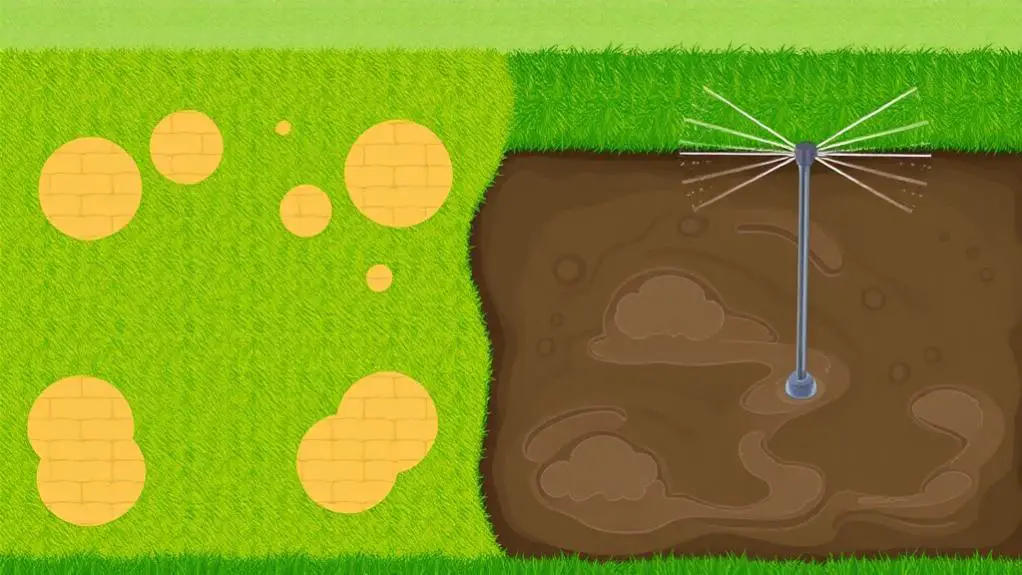
Overwatering or underwatering your lawn can wreak havoc on its health, and it's easier than you might think to make common watering mistakes.
One big mistake is watering too frequently for short durations, which leads to shallow root growth. Instead, aim for deep watering sessions of 30-60 minutes.
Another error isn't measuring the water applied; using a tuna can helps guarantee about 1 inch per week.
Also, avoid watering during the heat of the day to prevent evaporation.
Don't forget to adjust watering based on soil type.
Here are common mistakes to watch out for:
- Watering too frequently
- Not measuring water
- Watering during peak sun
- Ignoring soil type
- Using the wrong sprinkler system
Professional Help
Thinking about getting professional help for watering your lawn?
An irrigation expert can make sure your lawn gets just the right amount of water, tailored to your grass type, soil, and the season.
Plus, they can install smart systems that adjust to weather changes, saving you time and making sure your lawn stays lush and green!
Expert Lawn Management
When it comes to maintaining a lush, vibrant lawn, hiring a professional lawn care expert can make all the difference. They guarantee your lawn receives the appropriate amount of water tailored to its needs, which varies based on grass type and soil conditions.
Experts can assess and automate your irrigation system for best results, typically recommending 1-2 inches of water weekly.
Here's why you should consider a lawn care expert:
- Tailored watering schedules for your yard
- Efficient irrigation systems that save water
- Automated watering at prime times, like just before sunrise
- Regular maintenance to guarantee adequate watering
- More time for you to relax and enjoy your lawn
Efficient Watering Solutions
Hiring a lawn care expert guarantees your yard gets the tailored attention it needs, but let's explore how efficient watering solutions can take it to the next level. A professional irrigation expert can set up a smart irrigation system that adjusts to real-time weather, optimizing your lawn watering schedule. This means your lawn gets the right amount of water, saving both time and resources.
| Solution | Benefit | Duration |
|---|---|---|
| Smart Irrigation Systems | Real-time weather adjustments | 25-35 min (rotor heads) |
| Tailored Watering Plans | Custom schedules | 10-15 min (spray heads) |
| Expert Maintenance | Peak system performance | Consistent monitoring |
| Professional Installation | Optimized watering | Effortless upkeep |
Frequently Asked Questions
Is 20 Minutes Too Long to Water Grass?
I find that 20 minutes isn't always too long. It depends on watering frequency, grass health, and soil absorption. Drought conditions and weather impact also matter. Adjust your watering techniques based on these factors for ideal outcomes.
How Many Minutes Should I Water My Lawn?
I usually water my lawn for about 25-35 minutes per zone, twice a week. The watering frequency depends on soil moisture, grass type, weather conditions, and irrigation systems. Adjusting these factors guarantees ideal lawn health.
How Long Should Sprinklers Run in Each Zone?
When I run my sprinklers, I consider sprinkler types, watering frequency, and soil moisture. For zone efficiency, I adjust based on water pressure and seasonal changes. Usually, I set rotor heads for 30 minutes and spray heads for 12 minutes.
Is It Better to Water Your Lawn at Night or in the Morning?
I find that watering in the morning has clear benefits over evening watering. Morning benefits include better soil absorption and healthier roots, while evening drawbacks like increased humidity and pest activity can harm the lawn. Temperature impacts absorption efficiency.
Conclusion
Watering your lawn might seem tricky, but you've got this! Remember, aim for 30 minutes to an hour per session to keep those roots happy and healthy. Adjust your schedule based on the season, and don't forget to check the soil moisture. With the right techniques and a bit of patience, your lawn will thrive. Keep an eye out for common mistakes, and if you ever need help, don't hesitate to ask a pro. Happy watering!

